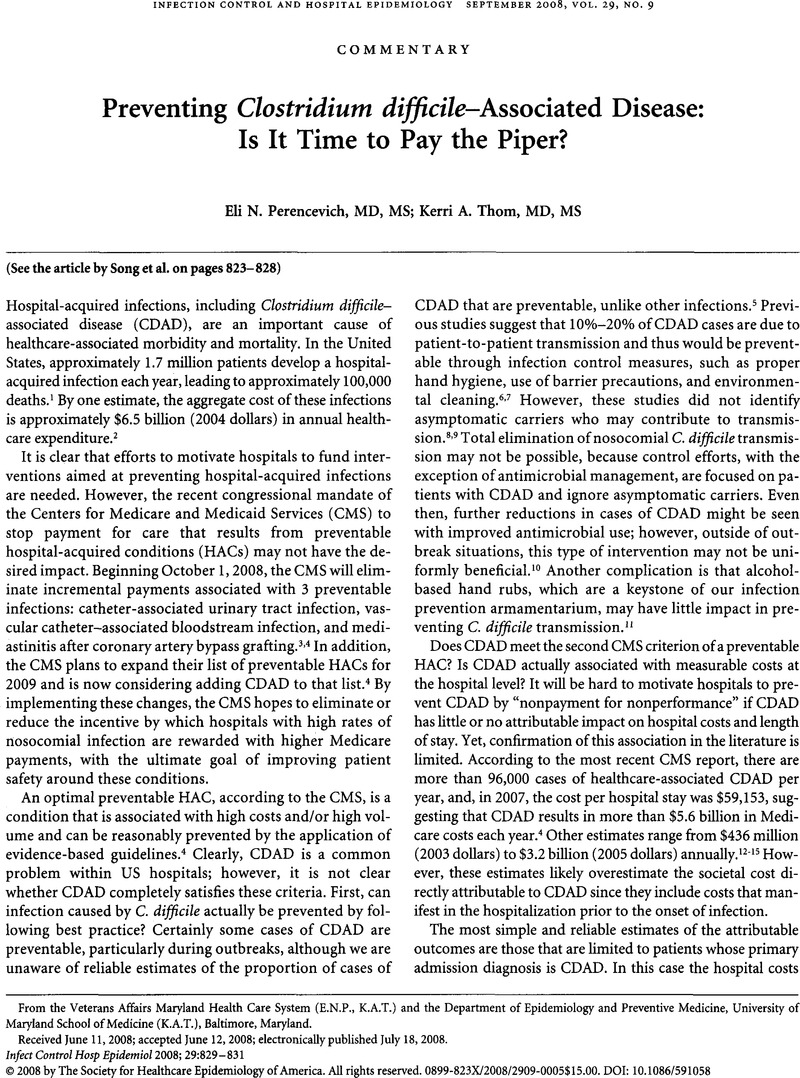Crossref Citations
This article has been cited by the following publications. This list is generated based on data provided by Crossref.
Cook, Evelyn
Marchaim, Dror
and
Kaye, Keith S.
2011.
Building a Successful Infection Prevention Program: Key Components, Processes, and Economics.
Infectious Disease Clinics of North America,
Vol. 25,
Issue. 1,
p.
1.
Wright, Marc‐Oliver
and
Perencevich, Eli N.
2011.
Molecular Techniques for the Study of Hospital‐Acquired Infection.
p.
55.
Pakyz, Amy
Carroll, Norman V.
Harpe, Spencer E.
Oinonen, Michael
and
Polk, Ronald E.
2011.
Economic Impact of Clostridium difficile Infection in a Multihospital Cohort of Academic Health Centers.
Pharmacotherapy: The Journal of Human Pharmacology and Drug Therapy,
Vol. 31,
Issue. 6,
p.
546.
Lipp, Michael J
Nero, Damion C
and
Callahan, Mark A
2012.
Impact of hospital‐acquired Clostridium difficile.
Journal of Gastroenterology and Hepatology,
Vol. 27,
Issue. 11,
p.
1733.
Dubberke, Erik R.
and
Olsen, Margaret A.
2012.
Burden of Clostridium difficile on the Healthcare System.
Clinical Infectious Diseases,
Vol. 55,
Issue. suppl_2,
p.
S88.
Eckmann, Christian
Wasserman, Matthew
Latif, Faisal
Roberts, Graeme
and
Beriot-Mathiot, Axelle
2013.
Increased hospital length of stay attributable to Clostridium difficile infection in patients with four co-morbidities: an analysis of hospital episode statistics in four European countries.
The European Journal of Health Economics,
Vol. 14,
Issue. 5,
p.
835.
Gabriel, L.
and
Beriot-Mathiot, A.
2014.
Hospitalization stay and costs attributable to Clostridium difficile infection: a critical review.
Journal of Hospital Infection,
Vol. 88,
Issue. 1,
p.
12.
Choi, Hyung-Yun
Park, So-Youn
Kim, Young-Ae
Yoon, Tai-Young
Choi, Joong-Myung
Choe, Bong-Keun
Ahn, So-Hee
Yoon, Seok-Jun
Lee, Ye-Rin
and
Oh, In-Hwan
2015.
The Epidemiology and Economic Burden ofClostridium difficileInfection in Korea.
BioMed Research International,
Vol. 2015,
Issue. ,
p.
1.
Dhar, Sorabh
Cook, Evelyn
Oden, Mary
and
Kaye, Keith S.
2016.
Building a Successful Infection Prevention Program.
Infectious Disease Clinics of North America,
Vol. 30,
Issue. 3,
p.
567.
Doll, Michelle E.
Zhao, Jinlei
Kang, Le
Rittmann, Barry
Alvarez, Michael
Fleming, Michele
Cooper, Kaila
Stevens, Michael P.
and
Bearman, Gonzalo
2020.
Chasing the rate: An interrupted time series analysis of interventions targeting reported hospital onset Clostridioides difficile, 2013–2018.
Infection Control & Hospital Epidemiology,
Vol. 41,
Issue. 10,
p.
1142.
Dhar, Sorabh
Sandhu, Avnish L.
Valyko, Amanda
Kaye, Keith S.
and
Washer, Laraine
2021.
Strategies for Effective Infection Prevention Programs.
Infectious Disease Clinics of North America,
Vol. 35,
Issue. 3,
p.
531.





